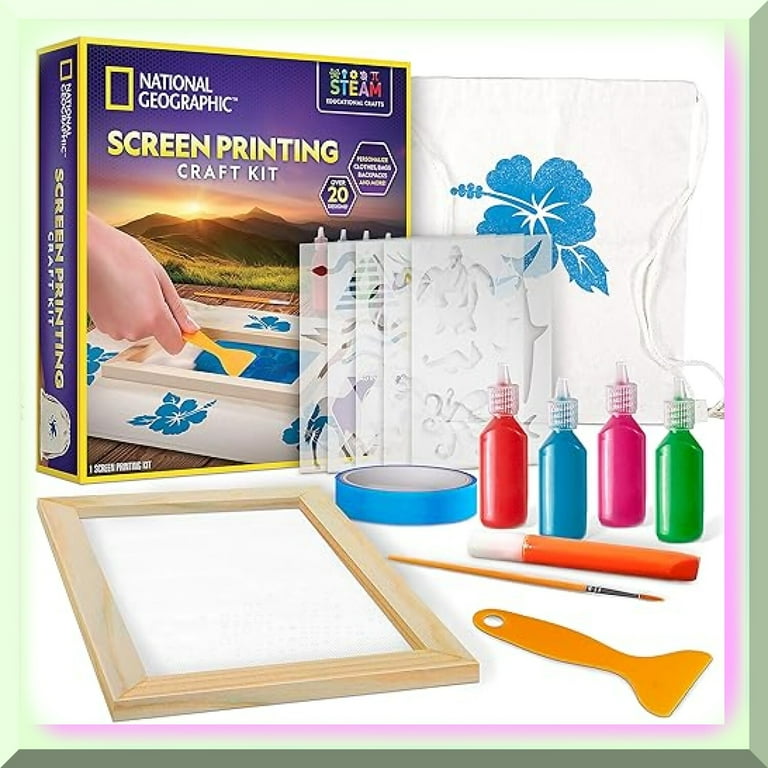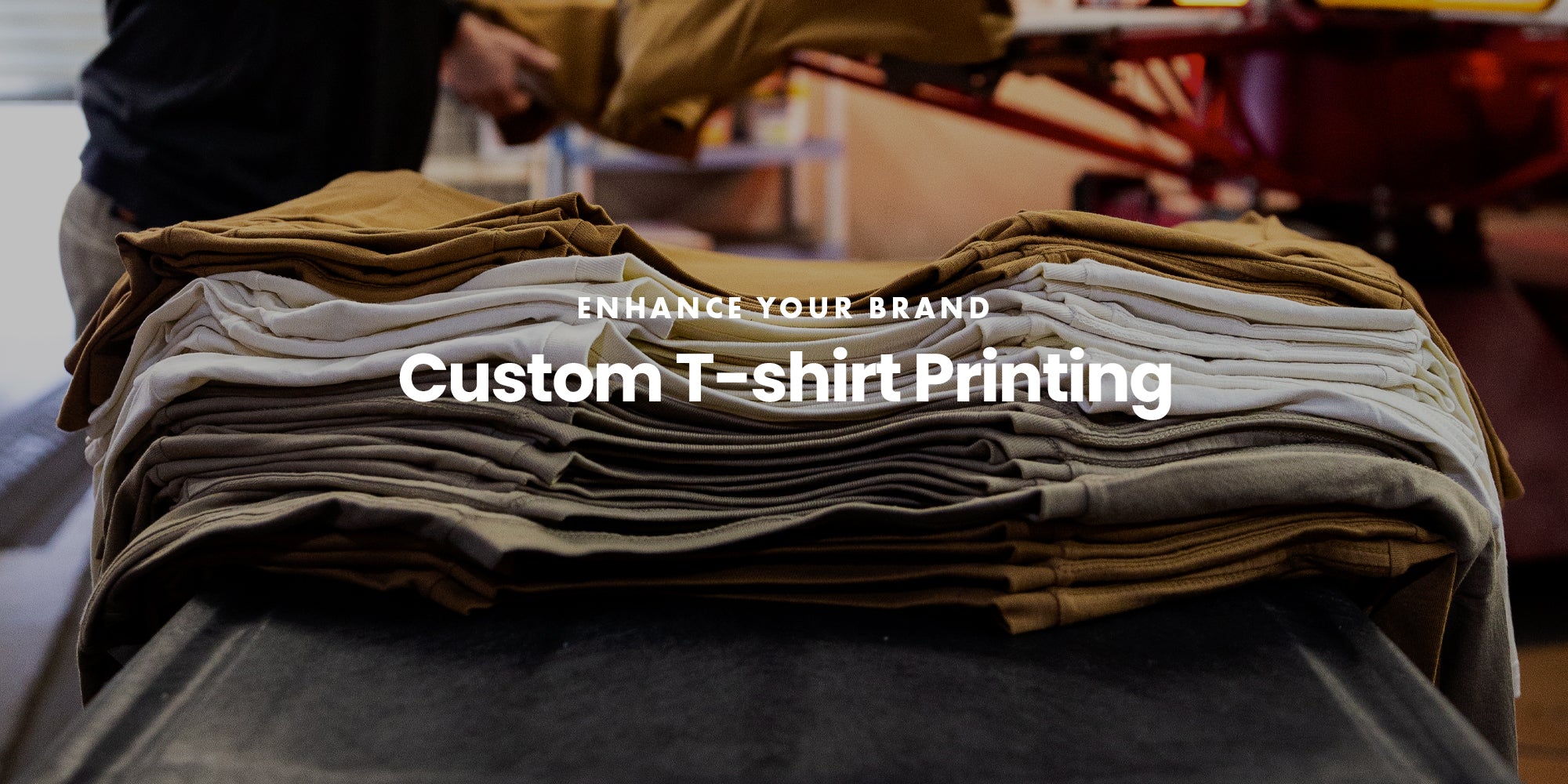Display Printing Uncovered: Whatever You Required to Understand About T-Shirt and Garment Printing Methods
If you've ever before questioned how those vibrant layouts finish up on your preferred tees, you're in the best place. Display printing is an interesting approach that integrates art with technique, supplying countless possibilities for imagination. Understanding the fundamentals, from tools to ink choices, can considerably influence your outcomes. All set to check out the vital components that make display publishing an art form? Let's reveal the details that can elevate your projects.
The Basics of Display Printing: Exactly How It Works
When you plunge into display printing, you'll uncover it's both an art and a scientific research. At its core, display printing entails creating a pattern, or display, that enables ink to go through only in specific areas (screen printing kit). You start by choosing your layout and preparing your display with a light-sensitive solution. When you expose this solution to light, it hardens, leaving your layout as a negative room.
Following, you'll mix your inks and prepare your printing surface area. Setting the display over the material, after that use a squeegee to push ink with the display onto the garment. This procedure needs precision, as you want clear, lively prints. After printing, you'll treat the ink with heat, guaranteeing it complies with the textile and lasts via washes. Each action is essential, and understanding them will certainly boost your screen printing skills, transforming simple garments right into special, meaningful pieces.
Kinds Of Display Printing Strategies
Once you grasp the essentials of display printing, it's time to explore the numerous strategies that can raise your designs. One prominent method is conventional display printing, where ink is pushed via a stenciled screen. This technique is wonderful for bold, vibrant colors. After that there's water-based ink printing, which uses a softer feeling and is green, yet it needs a various technique to treating.
If you're going for great details, take into consideration discharge printing. This method removes dye from the fabric, leaving a soft, classic appearance. One more alternative is plastisol printing, understood for its longevity and vivid colors, making it a favored for lots of brands. Experiment with halftone printing to create gradient results and elaborate styles. Each strategy has its special appeal, so do not think twice to attempt them bent on find what fits your design best!
Crucial Devices for Display Printing
To achieve stunning cause screen printing, having the appropriate equipment is essential. You'll need a tough screen printing framework, which holds the mesh that transfers your style onto the garment. Next off, buy premium mops; these are necessary for using ink evenly throughout the display. You'll also require an excellent exposure system to produce your displays, as well as a washout booth for cleansing them after use. A reliable warm source, like a conveyor dryer or heat press, is important for healing your prints to assure durability. Do not fail to remember a correct workspace, furnished with tables and storage space for your products. Protective gear, such as handwear covers and masks, will keep you secure from chemicals and inks. With the right tools, you'll be well on your means to generating professional-quality prints.
Picking the Right Inks and Products
When picking inks and materials for screen printing, you need to think about the kind of ink that functions ideal for your project. Believe regarding fabric compatibility to assure your styles look last and excellent long. Check out environmentally friendly ink choices to make your printing procedure extra sustainable.
Kinds Of Screen Inks
Picking the ideal screen ink is necessary for attaining vibrant, long lasting prints that meet your task's demands. There are numerous sorts of screen inks to examine. Plastisol ink is popular for its versatility and ease of usage, providing superb color opacity on dark materials. Water-based ink, on the various other hand, supplies a softer feeling and is environmentally friendly, making it perfect for those wanting to decrease their ecological impact. Discharge inks eliminate color from the textile, resulting in a soft, classic look however require specific handling. Lastly, specialized inks, such as glow-in-the-dark or metal, can include one-of-a-kind results to your layouts. Examine your task demands and choose the ink that straightens ideal with your wanted result.

Fabric Compatibility Considerations
Recognizing material compatibility is important for accomplishing top notch display prints, specifically considering that different materials react distinctly to various inks. When picking inks, consider the material kind-- cotton, polyester, or blends. For cotton, water-based inks function well, supplying gentleness and breathability. Polyester, on the other hand, commonly calls for plastisol inks for better bond and lively colors. If you're publishing on blends, you may need to utilize a combination of both kinds. Constantly examine your inks on sample textile to guarantee they adhere effectively and preserve shade stability. Additionally, maintain in mind that material weight and appearance can influence the final outcome, so picking the ideal ink and product combo i loved this is vital for your task's success.
Eco-Friendly Ink Options
Environmentally friendly inks are ending up being a preferred option for screen printers that desire to reduce their environmental effect while keeping top quality. When selecting inks, take into consideration water-based inks, which are less unsafe and simpler to cleanse up contrasted to typical solvents.
Furthermore, search for inks made from renewable resources, such as soy or vegetable-based choices. By choosing the best inks and materials, you'll not only create sensational designs but additionally add to an extra sustainable printing process. Make the button, and your prints will mirror your dedication to the environment!
Preparing Your Layout for Display Printing

Submit Style Requirements
To assure your design looks vibrant and sharp on material, you'll require to pay close interest to file format needs for display printing. Make sure your design has a transparent history to avoid undesirable white sides on your prints. Maintain shade modes in mind; CMYK is basic for screen printing, so transform your RGB develops as necessary.
Color Separation Methods
Color splitting up is an important step in preparing your layout for display printing, and mastering it can significantly improve your print high quality. You'll require to damage your style right into private shades, as each shade requires a different display throughout printing. Begin by recognizing all the colors in your design and create layers for each one. You can use software application like Adobe Photoshop or Illustrator to separate and different colors effectively. Be specific to conserve each layer as a separate file, generally in a style like TIFF or PSD. This accuracy not only assures accurate shade depiction but also streamlines the printing process. By focusing on shade separation, you'll attain vibrant and expert results in your screen-printed garments.
Resolution and Dimension
Attaining the finest lead to display printing starts with ensuring your style has the appropriate resolution and dimension. Preferably, your art work needs to go to the very least 300 DPI (dots per inch) for sharp, clear prints. Your last product might look pixelated and unprofessional. if you utilize lower resolution.
When it pertains to dimension, consider the measurements of your print location. Style your art work to match the last print size, ideally developing it in the real measurements you'll be publishing. In this manner, you'll avoid any unanticipated scaling problems.
Always examine your style in both vector and raster layouts. Vector graphics can be scaled without losing top quality, making them ideal for screen printing. Preparing appropriately will assure your layout looks remarkable on every garment!
Step-by-Step Screen Printing Process
Screen printing is a dynamic procedure that allows you to produce lively styles on various surface areas. To get begun, you'll require a screen, emulsion, and your chosen ink.
After cleaning out the unexposed solution, your screen prepares. Establish it up on your printing surface and align your garment underneath it. Pour ink onto the screen and utilize a squeegee to press the ink via the stencil onto the material. Raise the screen carefully and allow the print completely dry. Treat the ink making use of warmth to assure resilience. That's it! You have actually successfully display printed your design.
Tips for Successful Screen Printing Projects
While you're diving into your display printing jobs, bear in mind that prep work is essential to success. Beginning by gathering all your products-- inks, garments, squeegees, and displays. A clean work area assists prevent undesirable mistakes, so official statement tidy up prior to you begin.
Next, verify your artwork is high-resolution and appropriately sized for your garment. Examine your display for correct direct exposure and clean it extensively to stay clear of smudges. When mixing your inks, comply with the maker's standards to attain the best uniformity.
During printing, use even pressure with your squeegee for constant outcomes. custom screen printing Do not hurry; take your time to verify each print satisfies your requirements. After printing, allow your garments dry entirely prior to managing or packaging them.
Finally, always keep a sample of your work for future referral. By doing this, you can examine your progression and enhance your strategies over time. Happy printing!

Regularly Asked Inquiries
The length of time Does It Require To Set up a Screen Printing Task?
Setting up a screen printing job generally takes around 30 mins to an hour. You'll prepare the screens, mix inks, and readjust journalism. The moment differs based upon intricacy and experience, so stay arranged!
Can I Publish on Different Fabric Keys In Utilizing the Very Same Strategy?
Yes, you can print on various textile types using the very same technique, yet you'll need to change your inks and setups. Some materials absorb ink in a different way, so trying out guarantees the most effective results for every material.
What Prevail Errors to Stay Clear Of in Screen Printing?
When screen printing, prevent usual mistakes like using the wrong ink, neglecting correct exposure times, or skipping pre-press checks. Constantly test your arrangement and preserve clean screens to ensure high quality outcomes each time.
Exactly How Can I Effectively Tidy and Preserve My Display Printing Tools?
To correctly clean and maintain your screen printing tools, you must regularly clean screens with appropriate solvents, examine mops for wear, and assure all tools are saved dust-free and dry. Consistency prevents costly repairs and enhances performance.
Is Screen Printing Eco-friendly Compared to Various Other Methods?
Screen printing can be much more environmentally pleasant than other approaches, particularly if you make use of water-based inks and eco-conscious products. By choosing sustainable materials and techniques, you minimize waste and decrease your effect on the earth.
Display Printing Uncovered: Whatever You Required to Know About Tee and Garment Printing Strategies
At its core, display printing includes creating a stencil, or screen, that allows ink to pass with only in details locations. Setting the screen over the fabric, then utilize a squeegee to press ink with the display onto the garment. One preferred approach is standard display printing, where ink is pushed through a stenciled screen.When selecting inks and products for display printing, you need to take into account the type of ink that functions best for your task.